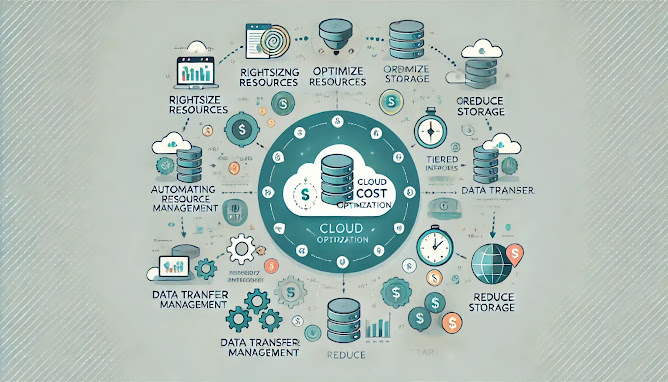Effective cloud cost optimization goes beyond just reducing expenses; it’s about maximizing your return on investment (ROI) without compromising performance, security, or availability. This article explores techniques I've used to help organizations control and reduce cloud expenses. Whether you're new to the cloud or looking to refine your existing strategy, these insights can help you extract maximum value from your cloud investment.
1. Understanding Cloud Costs
and Why Optimization is Essential
To optimize cloud expenses, it’s
crucial to understand what drives these costs and why proactive management is
necessary. Many businesses are drawn to the cloud’s pay-as-you-go pricing
model, where you only pay for what you use. However, without careful management,
this flexibility can lead to unchecked spending.
Common Cloud Cost Drivers
- Compute Resources: Virtual machines (VMs),
containers, and serverless functions often represent a large portion of
cloud costs. Misconfigured or oversized resources and idle systems can
quickly increase your bill.
- Storage: Cloud storage incurs ongoing
charges, from databases to backup files. Inefficient data management and
unnecessary duplication can drive costs up.
- Data Transfer: Moving data across regions,
between clouds, or to on-premises locations adds fees. Minimizing
unnecessary data transfers is essential to manage these costs.
- Managed Services: While managed services
streamline operations, they come at a cost. These charges can add up if
not regularly reviewed and optimized.
2. Key Techniques for Cloud
Cost Optimization
Cost optimization involves
strategic planning, continuous monitoring, and making adjustments as needed.
Here are some of the most effective methods to help manage and reduce cloud
costs.
Rightsizing Resources
Rightsizing involves tailoring
your resources to fit actual demand. This means analyzing utilization rates and
adjusting accordingly to avoid paying for unused capacity.
- Monitor Utilization: Leverage monitoring
tools to track resource usage and identify underutilized resources that
can be downsized or terminated.
- Choose Optimal Instance Types: Selecting the
right instance type for your workload can result in significant cost
savings.
Leveraging Reserved Instances and Savings Plans
Reserved Instances (RIs) and
Savings Plans provide substantial discounts compared to on-demand pricing.
These plans work well for consistent, predictable workloads.
- Analyze Usage Patterns: Identify predictable
workloads, such as production databases or applications, and consider
Reserved Instances or Savings Plans.
- Compare Options: Each provider offers
savings plans with varying flexibility. Choose the one that best fits your
business needs.
Automating Resource Management
Automation is invaluable in cost
optimization. Automated scheduling, starting, stopping, and scaling ensure that
resources are used efficiently.
- Implement Auto-Scaling: Auto-scaling allows
you to match capacity with demand, ensuring you aren’t paying for idle
resources.
- Schedule Non-Production Environments:
Schedule non-production resources, like development environments, to shut
down during off-hours.
Optimizing Storage and Data Management
Cloud storage costs can escalate
quickly. By using the right storage types and managing data lifecycles, you can
significantly reduce expenses.
- Use Tiered Storage: Move infrequently
accessed data to lower-cost storage options.
- Data Lifecycle Policies: Set up policies to
transition or delete data based on age or access patterns.
3. Continuous Monitoring and FinOps: Accountability and Efficiency
Cost optimization requires
ongoing monitoring and a culture of accountability, also known as FinOps.
FinOps brings finance, IT, and business teams together to manage cloud costs
effectively.
Implement a FinOps Framework
FinOps ensures financial
accountability and encourages data-driven decisions on cloud spending.
- Build Cross-Functional Teams: Involve
finance, IT, and business stakeholders to monitor and manage cloud
expenses.
- Utilize Cost Management Tools: Cloud-native
tools like AWS Cost Explorer and Azure Cost Management provide visibility
into cloud costs.
Set Budgets and Alerts
Setting budgets and alerts helps
prevent overspending by monitoring usage in real-time.
- Project Budgets: Assign budgets to teams or
projects to monitor spending effectively.
- Automate Alerts: Set alerts for unusual
spending patterns to catch potential issues early.
Final Thoughts
Cloud cost optimization is
crucial for maximizing ROI and ensuring that your cloud investment delivers
value. By applying these strategies, such as rightsizing resources, leveraging
savings plans, automating tasks, and embedding a FinOps culture, organizations
can maintain control over cloud spending and drive financial accountability.
In my experience, organizations
that approach cloud cost optimization proactively, adopting both technical and
strategic measures, are the ones that unlock the cloud’s full potential. It's
not just about saving money—it's about empowering your business to innovate,
compete, and thrive in a digital landscape.

Comments
Post a Comment
Appreciate your Feedbacks\Comments